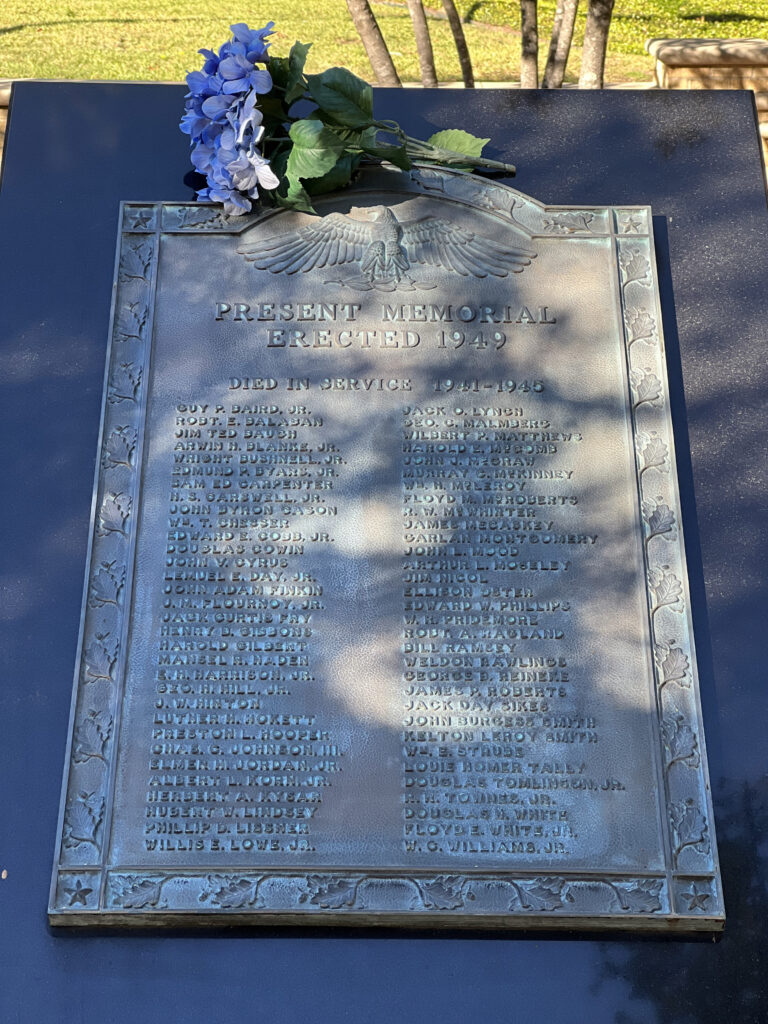Veterans Plaza: Remembering Fallen Frogs
The Horned Frogs hold a long and proud tradition of answering the call of duty when their country needs them, though, not all who answered would ever return home. How could the university honor their fallen classmates? The class of 1923 decided to build a memorial for the fallen Frogs, which has been extended and remodeled over the past one hundred years.
Memorials are built to stand the test of time for the soldiers that died too young, but how effective is that memorial if it goes unnoticed and forgotten?


The earliest announcement came from an article in The Skiff titled “In Commemoration of Valiant Deeds,” published on April 7, 1919. In this article the student body honored veterans with parades and fireworks, but this was for the soldiers that came back alive. What about those who were lost in battle? In the later section of the article the author illuminated the student body’s call to find a way to permanently celebrate those who did not come home.[1]
The memorial was set in the heart of campus in front of Reed Hall, where the original design was an archway that stood twenty-one feet tall that connected two pillars. The names J. Aubrey Cooper, Herndon Hardwick, and Milus Little Jr. were inscribed along the arch in honor of their sacrifice. An article from 1923 titled, “Class Honors World War Veterans,” published a week before the initial construction of the Arch, described the planned memorial. Written while the class of 1923 was still collecting donations for construction, this article offers an interesting look into the societal norms of the 1920s. The author calls for the student body to shame those that have offered to donate but have yet to make good on their promises.[2]
After construction was complete, the original design stood at the heart of campus for twenty-five years. Until, University Drive was widened in 1949, necessitating that the arch be torn down and the memorial was moved to fit the expanding street. The memorial was then redesigned into two columns with a new list of names added to commemorate the fallen Frogs that served in the Second World War.[3]

The new design of 1949 would not change for fifty-five years until 2004 when the memorial was widened to fit the names of more fallen Frogs. Not only does Texas Christian University have a long tradition of serving the nation when called, but also a tradition of honoring those who died. But how many students walk past the memorial on the way to class know what it is?

An article from TCU 360 published in 2014 adds an interesting challenge to the memorial’s efficacy at honoring the fallen. According to the article, some students and faculty agree that many on campus do not know what Veterans Plaza is or that it is in the middle of campus. Some perhaps are unaware that there even is a Veterans Memorial on campus, though current staff members are working diligently alongside veteran organizations like the Student Veterans Alliance to spread awareness.[4]
In conclusion, Texas Christian University has worked hard to honor those that served and died in service to the nation. But with the lack of awareness in the student body there is a worry that the sacrifices of the fallen will be forgotten. With the help of student veterans and faculty to spread awareness the memorial will continue to serve as a reminder to the community that Texas Christian University will always answer the call of duty.
[1] “In Commemoration of Valiant Deeds,” The Skiff, April 7, 1919, Special Collections, Mary Couts Burnett Library, Texas Christian University.
[2] “Class Honors World War Veterans,” The Skiff, May 15, 1923, Special Collections, Mary Couts Burnett Library, Texas Christian University.
[3] “Honoring the Supreme Sacrifice: War Memorial to Receive Makeover this Summer,” The Skiff, November 19, 2004, Mary Couts Burnett Library, Texas Christian University.
[4] “Veterans Plaza Unnoticed by Many Passing Students,” TCU360, March 14, 2014.
For Further Reading
Marcia Melton, “TCU’s Memorial Arch Dedicated to Those Who Served Humanity,” TCUMagazine, 2013.
The first resource that will expand your knowledge of Veterans Plaza is an article from TCU Magazine titled, “TCU’s Memorial Arch Dedicated to Those Who Served Humanity,” published in 2013. This article provides an excellent dive into the history of the memorial. This article tells the story of the founding class and details further the meaning behind the placement of the memorial.
“TCU Memorial Columns: What We Do for Others and The World.” Hometown by Handlebar, May 30, 2016,
The second resource is from the website Hometown by Handlebar. The articles title is “TCU Memorial Columns: What We Do for Others and The World,” published in 2016. This publication shows an outsider’s perspective of the memorial on campus as seen by the average citizen of Fort Worth. The article has an excellent selection of photographs that can bring the memorial to you.
Budreau, Lisa A. Bodies of War: World War I and the Politics of Commemoration in America, 1919- 1939 (New York: New York University Press, 2009).
Finally, the last resource to help contextualize memorials and societies feelings towards them is a book written by Lisa M. Budreau, titled Bodies of War, published in 2009. Bodies of War introduces the idea that memorials were used as tools to shape the narrative of wars and the validity of fighting them. This is backed by firsthand recollection from individuals who were tasked with memorializing the dead and give detailed descriptions on the façade of memorialization.